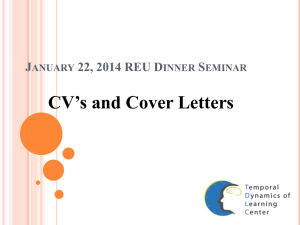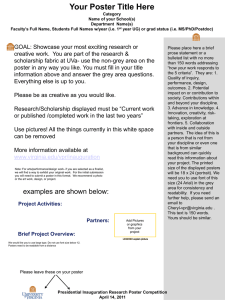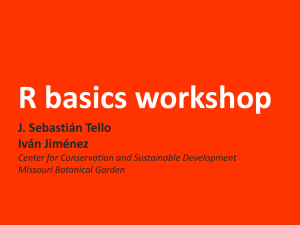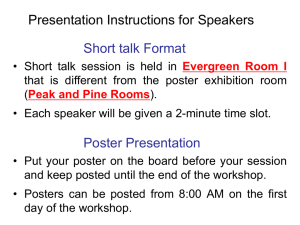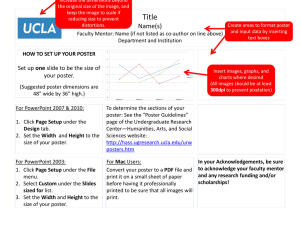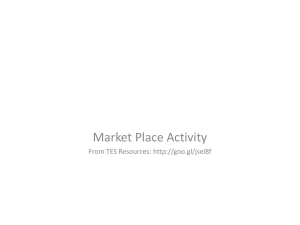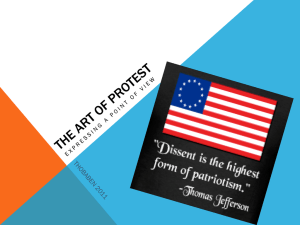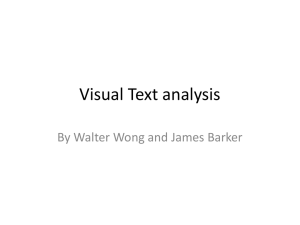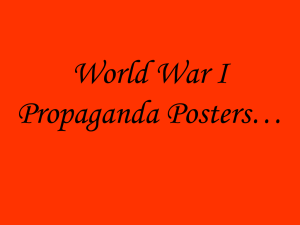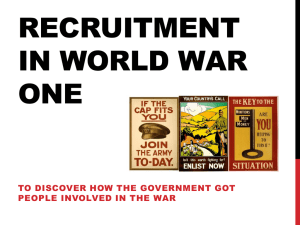Poster Presentations - Vanderbilt University School of Medicine
advertisement
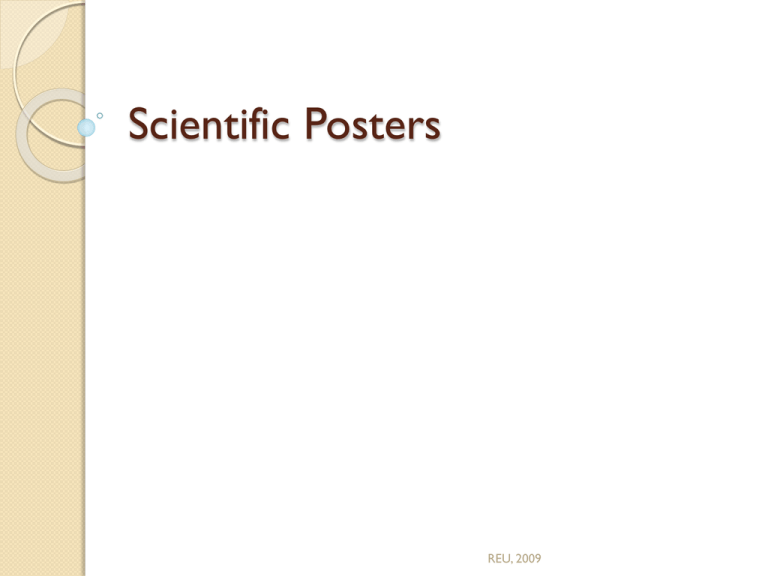
Scientific Posters REU, 2009 Scientific Posters • • • • • • Significant contribution to a meeting Part of professional education Provides information Develops your experience Builds networks and contacts Source of feedback REU, 2009 What is a scientific poster? A document used to communicate your research to a large group of people in intimate setting in 10 minutes or less. Informative teaser that invites someone in… You can get the purpose of the work in 20 seconds Poster usually highlight the most interesting aspect of the work, not the entire piece of work REU, 2009 Most people spend 90 seconds at a poster People come close when the items they read from afar appeal to them Crowded, disorganized posters are passed over Posters normally draw those with real interest who want to discuss the work REU, 2009 The Audience Who reads your poster? ◦ Those who follow your work ◦ Those in the same research area ◦ Passers-by Be ready to give a one - two minute introduction Rehearse answers to common questions Let the audience guide your discussion Only 1-2 will come at a time REU, 2009 Characteristics of effective presentations: Organized Rehearsed Visual appeal Relevant to audience Demonstrates enthusiasm REU, 2009 Poster Components Title Authors & lab affiliation Funding sources Light introduction Materials & Methods Results Literature Cited Further Information REU, 2009 Title Catchy 1 -2 lines Avoid the use of colons and cutesy / humorous terms Short and succinct is best Should allude to the research Sentence Case (ALL CAPS IS BAD!) REU, 2009 Authors & Affiliations List authors of the work which include PI and all other contributors Order of authors is determined by PI – very important Affiliation is the physical location where work was completed and the “home” of the PI Gain permission form PI prior to submitting any work for poster, oral or written communication REU, 2009 Funding You must list all funding sources for the work For our purpose this year it is NSF-REU program for funding your stipend. A grant program that is funding the actual research should also be listed (ask PI). Normally research presented without a funding source is suspect. Peer review grants give the work credibility. REU, 2009 Introduction Maximum of 200 words Quickly place your issue in the context of published, primary literature; provide description and justification of general experimental approach, and hint at why your study organism is ideal for such research; give a clear hypothesis. REU, 2009 Materials & Methods Max 200 words Briefly describe unusual or unique materials or methods used in the research Diagrams are best for instrumentation Flow charts help with experimental details REU, 2009 Results Unless the poster is about method creation, this will be the largest portion of the poster Includes appropriate raw data, interpretation of that data Be sure to address how this fits the hypothesis Visual aids: tables, graphs, computer generated illustrations, structures REU, 2009 Conclusions Frame the results in the context of the hypothesis List challenges and major advancements Connect to the literature Outline future directions of the work REU, 2009 Literature Citation Cite only references directly related to your work. Usually 5 key citations Use ACS Style for chemistry work or other appropriate citation format REU, 2009 Miscellaneous Further Information: A URL that others can access for more information or perhaps a short handout; optional Logos: You should include logos for the funding agencies and perhaps the institution for where the research took place Acknowledgements: People who contributed to work, less than 40 words REU, 2009 Size and font Title should be readable from 6 feet ◦ 120 font Helvetica, Arial, Universe Sub-heading from 3 feet and text from 2 feet. ◦ 60 font Text total : 800 words or less. ◦ 24 font, Times, Palatino, Bookman No block of text longer than 10 lines Italics instead of underlining Block letters, mixed case, no script REU, 2009 Formatting & Space Easier to read vertical text formatting than horizontal formatting Three column maximum Read top to bottom, left to right Be sure to leave at least a one inch margin all around About 25-30% white space is needed to keep the poster readable REU, 2009 REU, 2009 REU, 2009 Visual Balance and Symmetry Your poster should have a good visual balance of figures and text, separated by white space. Balance occurs when images and text are reflected (at least approximately) across a central horizontal, vertical, or diagonal axis. This axis is know as the axis of symmetry REU, 2009 http://www.ncsu.edu/project/posters/NewSite/CreatePosterLayout.html REU, 2009 REU, 2009 Color Theory Text should be in black, highlights in color Best if background is white or light colored REU, 2009 Color Theory Be careful of red-green colorblindness Gratuitous use of color districts the reader Keep headings and titles in the same color Keep highlight colors to three Pastels and yellow are not good for text or graphics especially in large rooms with poor lighting REU, 2009 Graphs Do not use red-green color combo because of color blindness Do not use yellow because it is unreadable from 3 feet and gets lost in fluorescent lighting Line graphs only 3 lines Bar graphs, no more than 6 bars Avoid complex graphs- take too long to decipher REU, 2009 http://www.ncsu.edu/project/posters/NewSite/CreatePosterGraphics.html REU, 2009 Photos A thin black outline makes photos pop Good quality, high-resolution photos only At least 4x5 if you want to highlight details Need resolution of at least 300 (dots per inch) for good resolution when printed REU, 2009 Tables Avoid a table if a graph or other illustration can be used Make tables compact and include only the necessary data REU, 2009 Final Steps Have a friend review the poster for content and format before printing Proofread, proofread, proofread Allow 3-4 days for printing Have fun ! REU, 2009 Your Attire If your attire matches and does not clash with the poster, it will be visited more often and for longer periods Business attire, no flashy bling, no perfume or scented hygiene products Clothes freshly pressed Smile, keep your breath fresh REU, 2009 Templates Postersession.com MakeSigns.com PowerPoint REU, 2009
